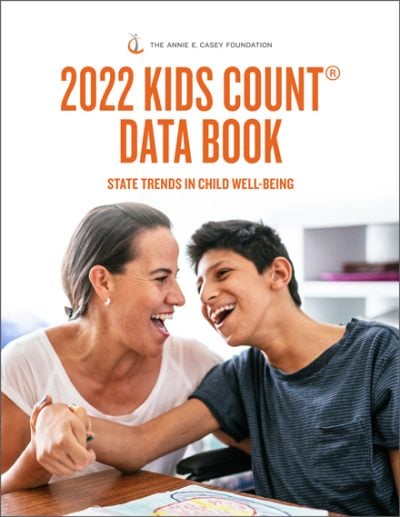
The 33rd edition of the Annie E. Casey Foundation's KIDS COUNT® Data Book describes how children in America are in the midst of a mental health crisis, struggling with anxiety and depression at unprecedented levels.
This year’s publication continues to present national and state data across four domains — economic well-being, education, health and family and community — and ranks states in overall child well-being. The report includes pre-pandemic figures as well as more recent statistics, and shares the latest information of its kind available.
The coronavirus pandemic has brought children trauma and tremendous loss over the past two and a half years. As of July 2022, the health crisis had killed more than 1 million people in America, including more than 1,600 children. During this same time span, more than 200,000 kids had lost a parent or primary caregiver to the virus.
These conditions have helped fuel what the U.S. surgeon general has called a mental health pandemic for youth. According to the Data Book, the incidence of anxiety and depression among kids has spiked. Comparing pre-pandemic to the first year of the COVID-19 crisis: The share of children struggling to make it through the day rose nearly 26% — from 9.4% (5.8 million kids) in 2016 to 11.8% (7.3 million kids) in 2020.
This pandemic within a pandemic has also laid bare persistent disparities. Across the United States, 9% of all high schoolers attempted suicide in the years before the most recent federal survey. This rate rises to 12% for Black students, 13% for students of two or more races and 26% for American Indian or Alaska Native high schoolers. Among LGBTQ youth, the statistics are similarly lopsided, with 23% of gay, lesbian or bisexual high schoolers reporting to have attempted suicide compared to just 6% of their heterosexual peers.
The 2022 KIDS COUNT Data Book continues to identify racial and ethnic disparities that persist in America today. Some examples of these findings include:
The stark racial and ethnic disparities shaping American childhoods today — which the KIDS COUNT Data Book series captures year after year — disproportionately result in and contribute to troubling mental health issues among children of color.
Early research indicates that addressing youth mental health needs can reduce or even eliminate pandemic-related stress. Accordingly, the Foundation calls on lawmakers to enact the programs and policies needed to ease mental health burdens on children and their families. They recommend:
In terms of overall child well-being, the top-performing states remained the same as last year, with Massachusetts leading the list, followed by New Hampshire (2) and Minnesota (3). Similarly, the lowest-ranked states remained the same but shuffled in rank. New Mexico fell one spot to 50, Louisiana fell one spot to 49 and Mississippi improved two spots to 48.
View the national data profile or download your state's data profile as a PDF below:
View the 2022 U.S. Data Profile in Spanish or download your state's data profile as a PDF below:
The Foundation calculates a composite index of overall child well-being for each state by combining data across four domains: (1) Economic Well-Being, (2) Education, (3) Health and (4) Family and Community. These scores are then translated into state rankings. Explore overall child well-being in the interactive KIDS COUNT Data Book.
To help children grow into prepared, productive adults, parents need jobs with family-sustaining pay, affordable housing and the ability to invest in their children’s future. Explore economic well-being data in the interactive KIDS COUNT Data Book.
The early years of children’s lives set the foundation for their lifelong success. Closing significant academic achievement gaps is vital to ensuring that the nation’s future workforce can continue to compete on a global scale. Explore education data in the interactive KIDS COUNT Data Book.
Good health is central to a child’s overall development and ensuring that kids are born healthy is an important first step toward lifelong success. Explore health data in the interactive KIDS COUNT Data Book.
Children who live in nurturing families and supportive communities have stronger personal connections and realize higher academic achievements. Explore family and community data in the interactive KIDS COUNT Data Book.